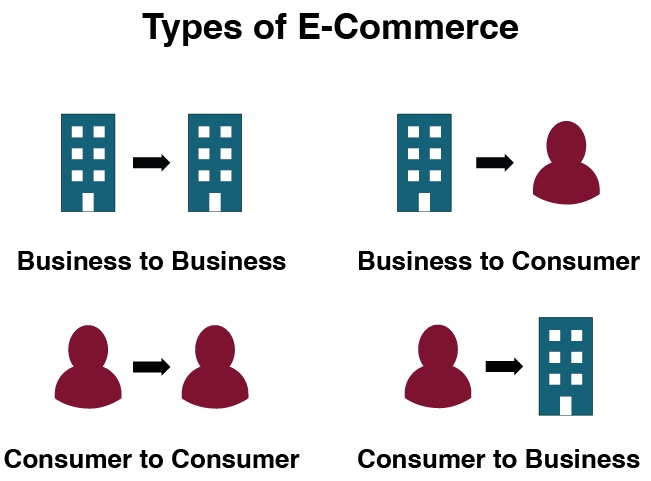10.5. Types of E-Commerce
Every internet business is either pure-play, or brick-and-click. A pure-play business, such as Amazon and Well.ca, has an online presence only and uses the capabilities of the internet to create a new business. Brick-and-click businesses, such as Indigo and Canadian Tire, combine a physical presence with an online presence. These businesses use the Internet to supplement their existing businesses (Krishnamurthy, 2003).
There are several different types of e-commerce that can describe almost every transaction that takes place between consumers and businesses.

| Business to Business (B2B) | When a business sells a good or service to another business. For example, a business that sells software-as-a-service for other businesses to use, or Staples selling office supplies. This is the largest form of e-commerce |
| Business to Consumer (B2C) | When a business sells a good or service to an individual consumer. For example, when you buy a pair of shoes from an online retailer like Nike. |
| Consumer to Consumer (C2C) | When a consumer sells a good or service to another consumer. The most well known C2C is eBay, but there are many other online market providers as well, like Kijijii or Craigslist. Peer-to-peer (P2P) are also a form of consumer to consumer. See more about P2P below. |
| Consumer to Business (C2B) | When a consumer sells their own products or services to a business or organization. For example, an influencer offers exposure to their online audience in exchange for a fee, or a photographer licenses their photo for a business to use. |
e-Commerce can also involve the government.
| Business to Government (B2G) | Defined as e-commerce transactions with the government. The internet is used for procurement, filing taxes, licensing procedures, business registrations, and other government-related operations. This is an insignificant segment of e-commerce in terms of volume, but it is growing. |
| Consumer to Government (C2G) | Defined as e-commerce transactions between the government and individuals. This would involve licenses and registrations, and paying taxes. |
M-Commerce
Mobile e-commerce (m-commerce) refers to the purchase of goods and services through wireless technology, such as cell phones and handheld devices. M-commerce is growing fast with an estimated 73% of all e-commerce sales being done via a mobile device (Loesche & Richter, 2018, March 6). This can be attributed to the fact that many people now own smartphones, and they are using them all the time. This has made it convenient to be able to leverage this technology to shop online.
Growth in M-Commerce
M-commerce transactions continue to grow as a result of the following:
- The number of global mobile users is steadily increasing every year, resulting in an increased demand for mobile websites and applications.
- The rapid adoption of e-commerce means that evolving customers are looking for more options across more devices.
- Improved technology has given mobile devices advanced capabilities and faster internet access enabling m-commerce to be available on even the most affordable devices.
- Broadband technology and lowering data costs mean more consumers have access to m-commerce even on affordable devices and data plans.
- Mobile users are looking for instant gratification online; this includes their online shopping needs. Increase in m-commerce for fast food, fresh produce and basic household items have been driven by this need for customers to get what they need when and where they want it.
Benefits of M-Commerce
| Access | Gaining access to the internet through mobile is easier and more affordable than desktop options. The falling costs of data and improved internet access on mobile mean more and more users have access to the internet via mobile than any other device. |
| Convenience | Mobile phones are always with us and being constantly connected enhances the benefits of anytime, anywhere use with no need to plug in to or log in to computers wherever they are situated. |
| Costs | Mobile devices are more affordable than computers and offer multiple uses reducing the need for an additional computer. Calls, messaging services, social media and news content are just a few of the reasons consumers would prefer to use a single device making mobile phones the obvious choice |
| Ease of use | Mobile phones are relatively easy and simple to use, and there is no need for a particularly digitally skilled consumer. They allow consumers to make instant purchases with little technical skill. |
| Mobile Payment | Security around online payments remains the biggest barrier to e-commerce. Mobile payments allow alternative options for transactions via mobile currencies, mobile wallets and alternative mobile only payment methods. Such easy and secure payment options make mobile the preferred choice for many users. |
| Rich Content | Advances in mobile processing power means content can be easily accessed on mobile web browsers and mobile applications. Rich media allows brands to better demonstrate a product’s key features, share testimonials, and showcase the use/look of the product or service. |
Peer to Peer (P2P)
Peer-to-peer is a form of e-commerce comprised of an online platform that connects individuals looking to transact with one another. Some examples of P2P are Etsy, Uber, Airbnb and TaskRabbit.
“What is Ecommerce?” by Shopify Business Encyclopedia is licensed under a Creative Commons Attribution 4.0 License unless otherwise noted.
“Chapter 16: E-Business and E-Commerce: The Difference ” from Maritime Management: Micro and Small Businesses by Matthew Pauley is licensed under a Creative Commons Attribution-NonCommercial-ShareAlike 4.0 International License, except where otherwise noted.

